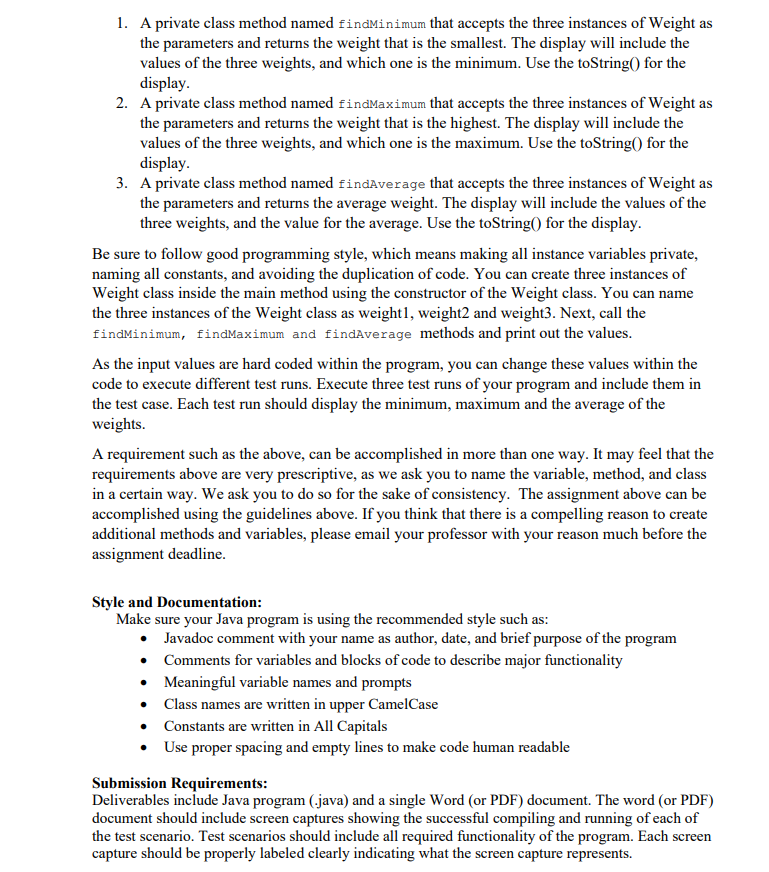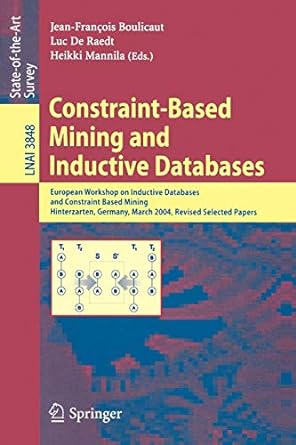


Object and Instance Before attempting this project, be sure you have completed all the reading assignments, non-graded exercises, discussions, and assignments to date. The first programming assignment involves writing a program that computes the minimum, the maximum and the average weight of three weights represented in pounds and ounces, and the values for the weight will be hard coded within the program. This program consists of two classes. The first class is the weight class, and this class will have two instance variables. The name of the first valuable is pounds, and the data type is of integer. The name of the second variable is "ounces, and the data type is a double precision floating point number. Both the instance variables must be private. The Weight class should have four public methods and two private methods, which are as follows: 1. A public constructor that allows the pounds and ounces to be initialized to the values supplied as parameters. 2. A public instance method named less than that accepts one weight as a parameter and returns whether the weight object on which it is invoked is less than the weight supplied as a parameter. 3. A public instance method named addTo that accepts one weight as a parameter and adds the weight supplied as a parameter to the weight object on which it is invoked. It should normalize the result. 4. A public instance toString method that returns a string that looks as follows: x lbs y oz, where x is the number of pounds and y the number of ounces. The number of ounces should be displayed with two places to the right of the decimal. You will use this method to print out the weight for display purposes. 5. A private instance method toOunces that returns the total number of ounces in the weight object on which it was invoked. This private method will be used (re-used) within the Weight class to help with various computations. 6. A private instance method normalize that normalizes the weight on which it was invoked by ensuring that the number of ounces is less than the number of ounces in a pound. This private method will be used (re-used) within the Weight class to help with various computations. In addition, the class should contain a private named constant that defines the number of ounces in a pound, which is 16. This class must not contain any other public methods. The second class should be named Project1. It should consist of the following four class (static) methods. 1. A private class method named findMinimum that accepts the three instances of Weight as the parameters and returns the weight that is the smallest. The display will include the values of the three weights, and which one is the minimum. Use the toString() for the display. 2. A private class method named findMaximum that accepts the three instances of Weight as the parameters and returns the weight that is the highest. The display will include the values of the three weights, and which one is the maximum. Use the toString() for the display. 3. A private class method named findAverage that accepts the three instances of Weight as the parameters and returns the average weight. The display will include the values of the three weights, and the value for the average. Use the toString() for the display. Be sure to follow good programming style, which means making all instance variables private, naming all constants, and avoiding the duplication of code. You can create three instances of Weight class inside the main method using the constructor of the Weight class. You can name the three instances of the Weight class as weight1, weight2 and weight3. Next, call the findMinimum, findMaximum and findAverage methods and print out the values. As the input values are hard coded within the program, you can change these values within the code to execute different test runs. Execute three test runs of your program and include them in the test case. Each test run should display the minimum, maximum and the average of the weights. A requirement such as the above, can be accomplished in more than one way. It may feel that the requirements above are very prescriptive, as we ask you to name the variable, method, and class in a certain way. We ask you to do so for the sake of consistency. The assignment above can be accomplished using the guidelines above. If you think that there is a compelling reason to create additional methods and variables, please email your professor with your reason much before the assignment deadline. Style and Documentation: Make sure your Java program is using the recommended style such as: Javadoc comment with your name as author, date, and brief purpose of the program Comments for variables and blocks of code to describe major functionality Meaningful variable names and prompts Class names are written in upper CamelCase Constants are written in All Capitals Use proper spacing and empty lines to make code human readable Submission Requirements: Deliverables include Java program (.java) and a single Word (or PDF) document. The word (or PDF) document should include screen captures showing the successful compiling and running of each of the test scenario. Test scenarios should include all required functionality of the program. Each screen capture should be properly labeled clearly indicating what the screen capture represents. The submiss requires uploading a single zip 1) The source code of Weight.java (do not include the class file) 2) The source code of Project1.java (do not include the class file) 3) A single document which can be either of the type Microsoft Word document, or a PDF. In this single document, include the test cases in a tabular format and the screenshot of the test runs for the test cases. You can copy and paste the screen shots in this document. Do not submit the screenshots separately but copy and paste in this document and finally submit a single document. Use the tabular format like the one shown below for the test cases. Test Case Input Values Expected Actual Result Did Test Pass Any Number Output of Output or Fail Comments Values Test 1 Test 1 Screen Shot(s) Test 2 Test 2 Screen Shot(s) And so on... Test 3 Test 3 Screen Shot(s) Grading Rubric Criteria Level 3 Level 2 Weight class (31-40 points) (21-30 points) Implemented the Not implemented some specifications and logic of the logic and components specification components Project class (31-40 points) (21-30 points) Implemented the Not implemented some specifications and logic of the logic and components specification components Test cases (11-20 points) (6 - 10 points) Included the test cases Not included some of with the screen shot(s) the test cases using the using the tabular format screen shot(s) using the tabular format Level 1 (0-20 points) Not implemented most of the logic and specification components (0-20 points) Not implemented most of the logic and specification components (0 - 5 points) Not included most of the test cases with the screen shot(s)









